Rail Trail

(Proposed Rail Trail path through Reedy Meadow - Photo courtesy of Steve Fantone)
RAIL TRAIL
Project Name: Wakefield/Lynnfield Rail Trail Extension - Projects #607329, #613163
Project Manager: John Scenna, Lynnfield Capital Program Director
This webpage is designed to provide a current status of the Rail Trail project. Below are the relevant elements of this project:
- Background
- Rail Trail Project Updates
- Frequently Asked Questions (FAQ's)
- Reports Related to the Design and Permitting Processes
- Rail Trail Plans
- Important Links
Background
The proposed Rail Trail is a centrally located, ADA compliant recreational path that will connect many of the landmarks of Lynnfield including Reedy Meadow, the Lynnfield Middle School, the proposed library at Reedy Meadow Golf Course, Bethlehem School at St. Paul’s Episcopal Church, and Lynnfield High School. It also passes within a quarter mile of the Summer Street School, Lynnfield Town Hall, and the Town’s center commercial district. The Rail Trail will provide a safe and convenient path for traveling between these locations, walking, jogging, biking or just meeting friends and enjoying the natural beauty of Reedy Meadow. In effect, this trail will provide an alternative transportation route that connects many of the most frequently accessed destinations in town.
The Lynnfield section of the proposed Rail Trail is a 2.8-mile-long multi-use path and boardwalk extending from Nichols Lane in Peabody through Lynnfield to Fosters Lane in Wakefield. The Wakefield section will extend an additional 1.6 miles from Fosters Lane to the Galvin Middle School.
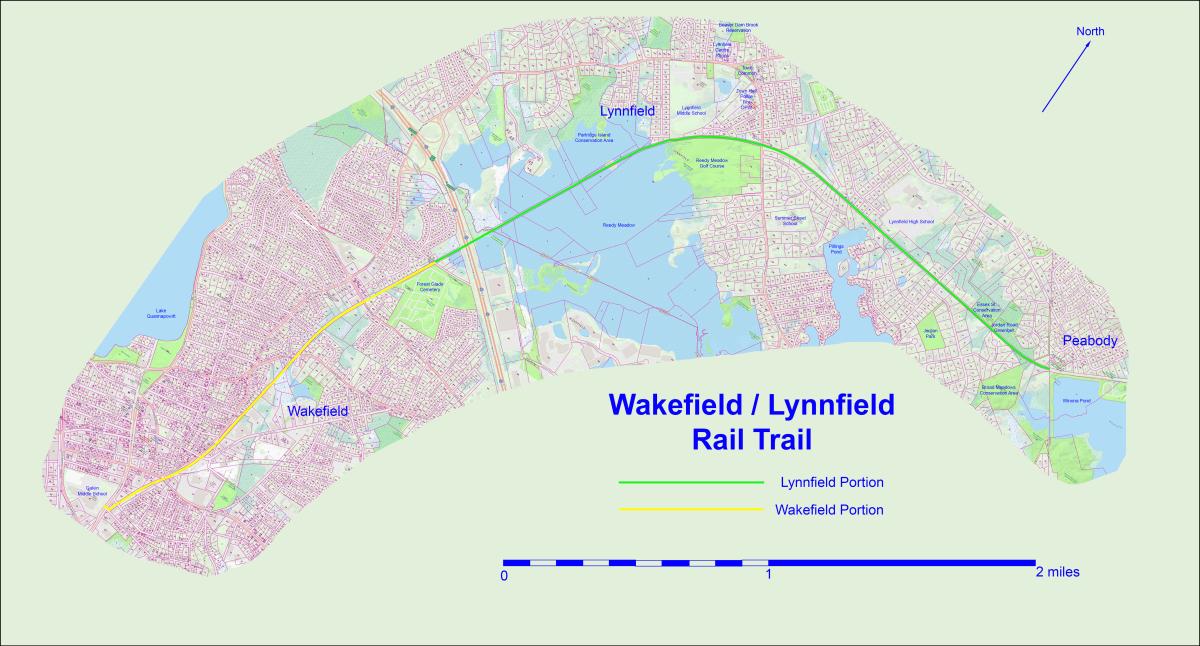
The Rail Trail corridor is the southern section of the former Newburyport Railroad that once connected Lynnfield to Newburyport. This corridor connects, via Peabody and Danvers, to the Border to Boston Trail, a proposed, 30-mile rail trail linking eight Essex County communities– Danvers, Wenham, Topsfield, Boxford, Georgetown, Newbury, Newburyport, and Salisbury.
The 25% design process for the project was completed in 2019. The 75% design is in process and was initiated by the recently hired design consultant, Stantec, in early 2023. Stantec's current schedule anticipates that design and permitting will be completed, State funding for construction will be available, and construction bids will be solicited in May 2026. MassDOT is currently evaluating the readiness of projects for funding years 2024 to 2029. MassDOT's upcoming "Tip Readiness Days" will likely determine the actual funding year for the Lynnfield RT project.
Rail Trail Project Updates
February 7, 2024 Update:
The Rail Trail project team will provide a public presentation at the 2/26/2024 Select Board meeting. The presentation will be led by Town Administrator Robert Dolan and Lynnfield Capital Program Director John Scenna, who recently transitioned in early January to fully managing the Rail Trail Project efforts alongside DPW Director & Town Engineer John Tomasz. In the upcoming months, the Rail Trail team will be working and preparing for the June MassDOT submission with field work, survey work and Geotech work in the Meadow. A Hydraulic Study will be completed during this time as well and Stantec will use all this information to develop bridge sketch plans that are the most significant item in the June submission to MassDOT. The team will also further explore and develop site plans, including walking paths around Turtle Island, crossings at Summer Street and Pillings Pond Road, and connections to the Middle School and High School athletic complexes. The project has some significant permitting challenges in the upcoming year as outlined within the presentation slides. As such, it will be working closely with Director Emilie Cademartori and the Planning & Conservation Departments to outline possible upcoming permitting challenges, questions, and approach, including how best to create and develop a phragmites mitigation plan. The Town Administrator’s Office will be working with Town officials in Wakefield to create a design memorandum of understanding with Wakefield and with legal counsel to begin the process of executing a long-term lease for the rail right of way and insurance procurement.
Rail Trail Project Update Presentation.Stantec.January 30, 2024
March 7, 2024 Update:
A contractor working under direction of the DPW has recently cleared vegetation from the Rail Trail corridor through Reedy Meadow to enable the completion of data gathering to support the geotechnical report, hydraulic study and wetlands permitting. Supplementary wetlands delineation, geophysical investigation and surveying will be occurring in April. The project team will also be meeting with MassDOT in March to review the updated construction cost estimate and State TIP funding status.
Photos from the March 4 site walk are here below:
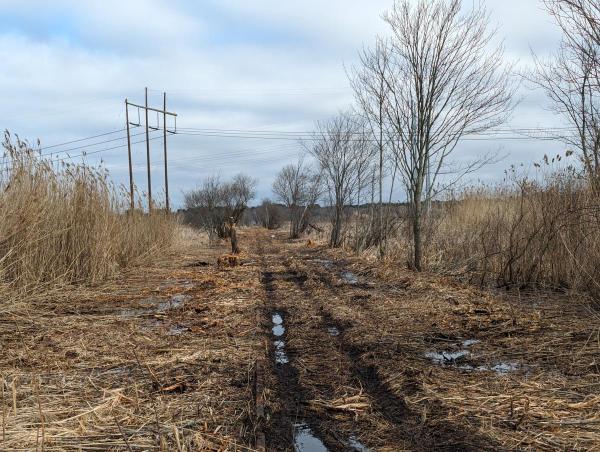
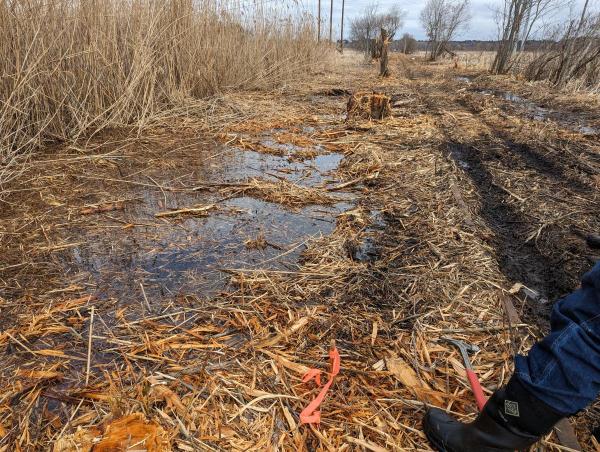
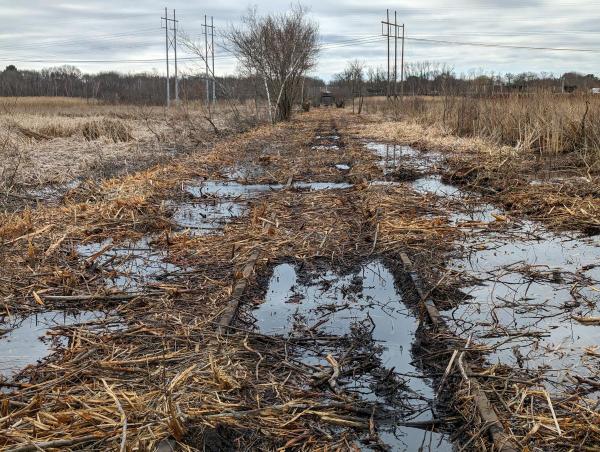
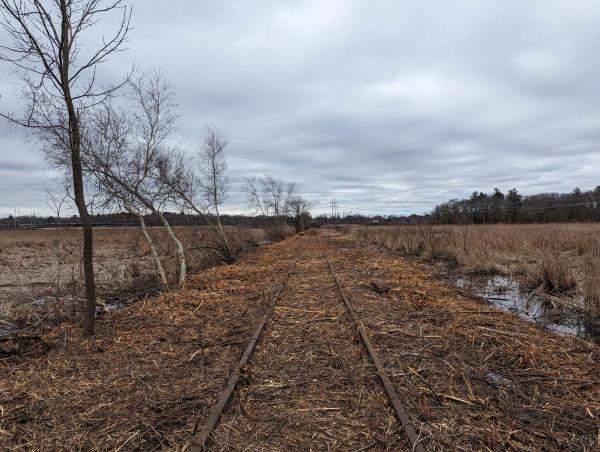
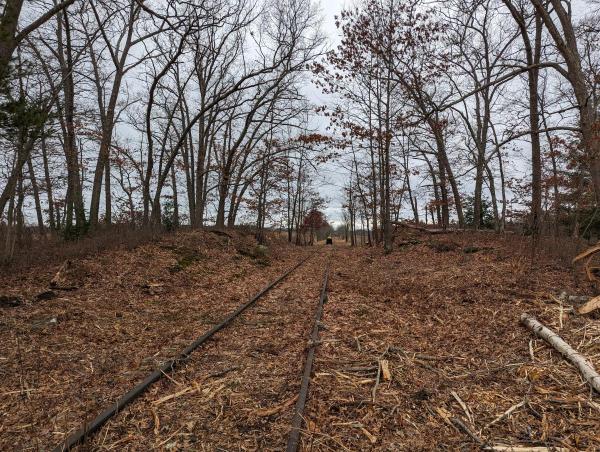
***************************************
Frequently Asked Questions (FAQ's)
When will the Rail Trail be open in Lynnfield?
The Town of Lynnfield recently coordinated with MassDOT and the Town of Wakefield to separate Lynnfield’s section of the Rail Trail from Wakefield’s section. This separation will enable Lynnfield to proactively manage the design and permitting of the Lynnfield section, using a new design consultant (Stantec) that is dedicated to the design and permitting of the Lynnfield section. Despite some delay caused by effecting the project separation and retaining a new design consultant, the Town is optimistic that the design and permitting can be completed to support a construction start in 2026 or 2027. If the permitting process goes smoothly, the Rail Trail may be open in 2028 or 2029.
Why is the design and permitting such a lengthy process?
Since the construction of the Rail Trail will be funded and executed by MassDOT (also using federal funds), the design must be completed by the Town’s design consultant in accordance with all MassDOT and Federal Highway standards. The design must also receive approval of several regulatory bodies due to the location of the Rail Trail within environmentally sensitive areas (see below). Design reviews are conducted by MassDOT at various stages including 25% design, 75% design, 100% design, and Plans, Specifications and Estimates (PSE). The 25% design has already been completed and approved by MassDOT. After completion of the design and permitting, the project will be publicly advertised for bidding by potential contractors. MassDOT will select a contractor based on price, qualifications, and experience and will administer construction of the project.
What is the Environmental Permitting that will/has been done during this project and what is the importance of these processes?
Under the new arrangement with MassDOT, the Town of Lynnfield is responsible for the design of 2.8 miles of Rail Trail extending from Fosters Lane in Wakefield to Nichols Lane in Peabody. Approximately one mile of the Lynnfield section will pass through wetlands, floodplain, and/or rare and endangered species habitat. Most of this one-mile portion will be designed as an elevated boardwalk.
Wetlands and Waterways Permitting - The project will result in temporary and/or permanent impact to Wetland Resource Areas, subject to jurisdiction under the Massachusetts Wetlands Protection Act. The project will require filing a Notice of Intent (NOI) Application in Lynnfield and Wakefield for work in and adjacent to the Wetland Resource Areas, a Pre-Construction Notification (PCN) Application with the US Army Corps of Engineers (USACOE), and a Water Quality Certification (WQC) with the Massachusetts Department of Environmental Protection (MADEP).
The Saugus River and Beaver Dam Brook may be considered navigable nontidal streams by MADEP Waterways, requiring a Waterways License for the construction of the boardwalk over the Saugus River and Beaver Dam Brook in Reedy Meadow in accordance with the Public Waterfront Act (Chapter 91) and the MADEP Waterways Regulations.
Threatened and Endangered Species - Portions of the project will extend through Priority Habitat of Rare Species/Estimated Habitat of Rare Wildlife. Specifically, Reedy Meadow is known habitat for the following birds that are classified as endangered, threatened, or of special concern: American Bittern, King Rail and Common Moorhen. Reedy Meadow is also known habitat for the endangered Glaucous Sedge plant.
The Massachusetts Natural Heritage and Endangered Species Program (NHESP) has determined that the proposed project will result in a "take" of state-listed rare birds under the Massachusetts Endangered Species Act (MESA) and will require a Conservation and Management Permit (CMP) that will include habitat mitigation in the form of invasive species management within Reedy Meadow.
Massachusetts Environmental Policy Act (MEPA) – The project will require State Agency Action for issuance of a MADEP WQC and NHESP CMP and will exceed the regulatory thresholds for disturbance of designated Priority Habitat and for wetland impacts, requiring the filing of an Environmental Notification Form (ENF) under MEPA. Cumulative wetland impacts for the rail trail and for the rare species mitigation will alter more than one acre of wetlands, thereby exceeding the regulatory threshold and requiring the filing of a mandatory Environmental Impact Report (EIR). The EIR will also be required to address impacts of the project on a nearby Environmental Justice Population in Wakefield.
What is the currently estimated timeline of the design, permitting and construction of the project?
See Stantec's timelines for design, permitting and right-of-way acquisition below:
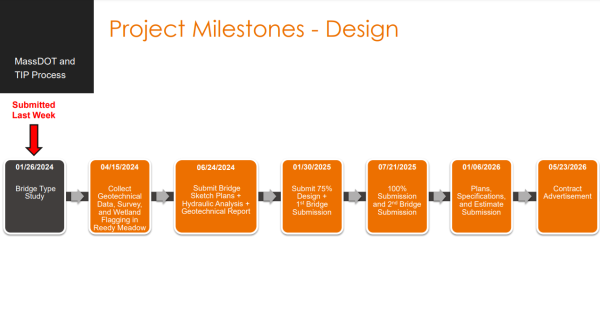
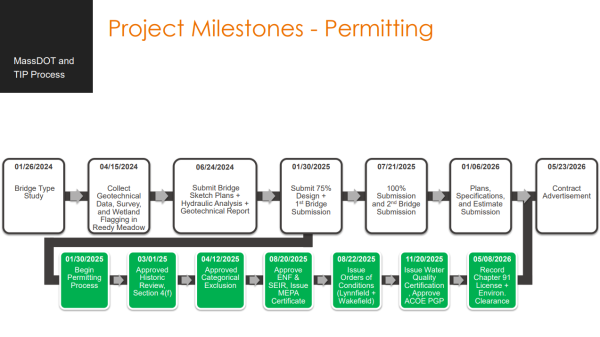
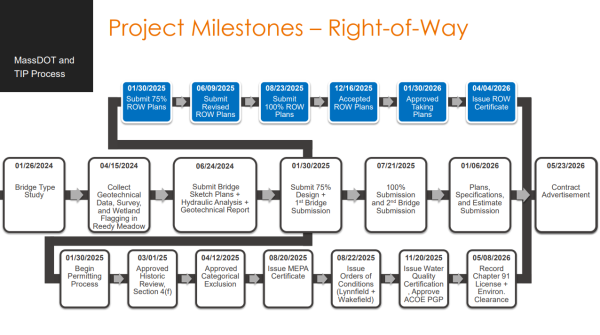
Reports Related to the Design and Permitting Processes
- 2007 Feasibility Study by Fay Spofford & Thorndike (acquired by Stantec)
- 2018 Recreational Path Committee presentation to Lynnfield Select Board
- 2018 Recreational Path Committee Public Workshop presentation
Rail Trail Plans
Important Links
- Friends of the Lynnfield Rail Trail
- Wakefield Rail Trail
- Border to Boston Trail
- Peabody Independence Greenway
- East Coast Greenway
- June 14, 2023 - Press release - FY2023 MassTrails $200K grant award
- June 14, 2023 - Award letter - MassTrails $200K grant award - Lynnfield
- Stantec - Ongoing Trails Projects and Projects Within the Last 5 Years

